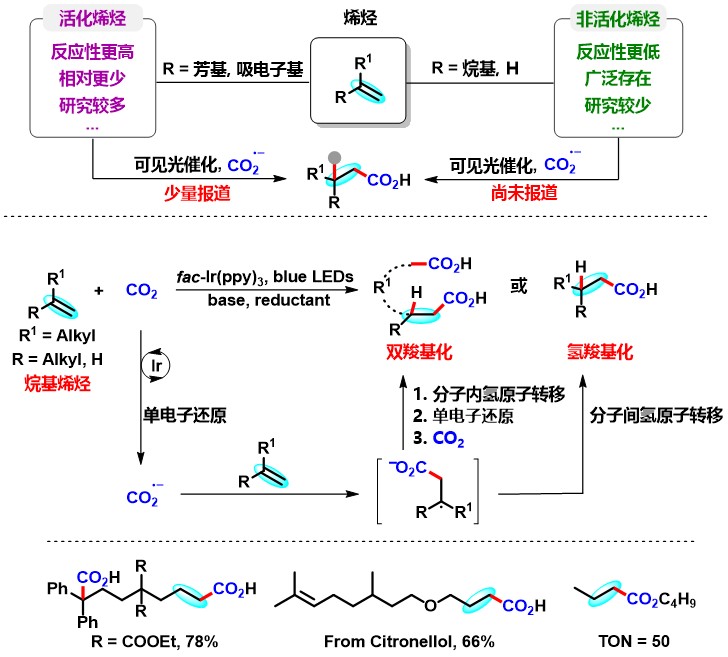Carbon dioxide is a greenhouse gas that has an important impact on climate change, and it is also a carbon resource which is cheap, easy to get, non-toxic and renewable. The use of carbon dioxide to produce by means of chemical transformation high-value added chemicals and bulk chemicals is an important way to serve the major strategic needs of the country, which is of great significance for promoting resource development and sustainable development. In recent years, people have used visible light to catalyze the reaction of alkenes with carbon dioxide, realized a series of carboxylation reactions with different chemical and regional selectivity, and synthesized a variety of important carboxylic acid products. In contrast, unactivated alkenes are generally more difficult to carboxylate with carbon dioxide than activated alkenes due to their lower reactivity. Therefore, it is of great significance to develop a new strategy to realize the visible light catalyzed carboxylation of unactivated alkenes with carbon dioxide.
In this case, SCU research team has recently published their findings in Nature Catalysis in an article titled “Visible-Light Photocatalytic Di- and Hydro-Carboxylation of Unactivated Alkenes with CO2”. Sichuan University is the first work unit, and Dagang Yu of the College of Chemistry is the corresponding author. The two first authors are Dr. Lei Song, and Wei Wang, a doctoral student of Class 2021.

“--- Catalytic carboxylation of alkenes with CO2to synthesize valuable carboxylic acids and diacids is highly important. Although visible-light photocatalytic single-electron transfer reduction of CO2could provide an alternative choice for diverse chemo- and regio-selectivities, it has rarely been investigated in carboxylation. Moreover, visible-light photocatalytic carboxylation of unactivated alkenes with CO2•−has never been reported. Here we report visible-light photocatalytic di- and hydro-carboxylation of unactivated alkenes with CO2. In contrast to previous reports limited to activated alkenes, diverse unactivated aliphatic alkenes undergo selective carboxylations to give carboxylic acids, dicarboxylic acids and unnatural α-amino acid derivatives in moderate to good yields. Mechanistic studies suggest that CO2might be reduced to CO2•−via consecutive photo-induced electron transfer, and this species would attack unactivated alkenes followed by subsequent hydrogen atom transfer and other relevant processes to afford the corresponding products.”(Abstract)
Financial support is provided by the National Natural Science Foundation of China (22225106, 21822108), Sichuan Science and Technology Program (20CXTD0112), Central Government Funds of Guiding Local Scientific and Technological Development for Sichuan Province (2021ZYD0063), Fundamental Research Funds from Sichuan University (2020SCUNL102) and the Fundamental Research Funds for the Central Universities.
https://www.nature.com/articles/s41929-022-00841-z
